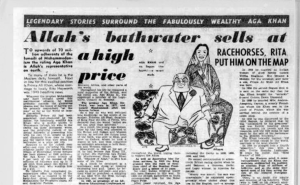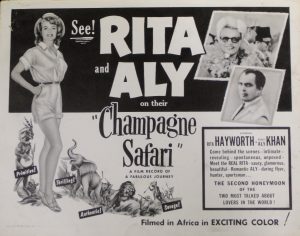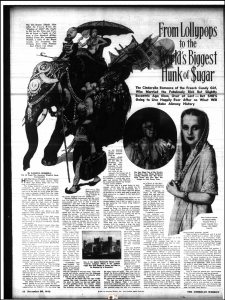An Australian newspaper published this article: Allah’s Bathwater Sells at a High Price
We acquired the article from the archives of the newspaper, which is available at this link.

You can read the article below:
To upwards of 70 million adherents of the Ismaili of Mohammedanism, the ruling Aga Khan is Allah’s representative on Earth.
To many of them, he is the Moslem deity himself. Next in line for this exalted position is Prince Ali Khan, whose marriage to lovely Rita Hayworth was 1949 headline news.
Whatever the Prophet Mohammed may have thought about this matrimonial alliance, he would probably concede the glamorous cinema star the honor of having put his princely descendant “on the map” as far as the world at large is concerned.
Hitherto, Prince Ali had been somewhat overshadowed by his father, the fabulously wealthy Aga Khan, who is mostly known to Westerners through his wins in the Derby, his three European wives, and the delightful custom of his devout followers of presenting him with his 17-stone weight in gold and diamonds from time to time and the legend that they drink his bathwater at a price per nip.
Reputed to be the richest man alive – not even excluding his rival religious leader, the present Moslem Nizam of Hyderabad, whose fortune has been guessed at GBP 500 million – the Aga Khan draws tribute of 2 percent of the income of his millions of followers and up to 10 percent from about two million of the Khoja sect who worship him as a god.
He inherits this remarkable remunerative office because he is counted to be the forty-first direct descendant of Mohammed the Prophet’s cousin Ali and daughter Fatima.
It was not nearly so remunerative, however, until Britain, in pursuit of an Empire in India, found it expedient about a century ago to extend its support and patronage to the Aga Khan’s grandfather, Hasan Ali Shah, in return for his influence among the Moslems.
Hassan Ali Shah, the descendant of the marriage of Ali and Fatima’s son Hossain to a daughter of the royal house of Persia, was born in Persia in 1800 and could trace his lineage back on the female side for centuries before the birth of Mohammed.
Some of his early ancestors ruled ancient Egypt.
His ancient lineage, however, did not prevent him from being hounded out of Persia when as Governor-General of Kerman, he offended the ruling Shah, Fateh Ali and he was forced to seek sanctuary in India.
On his way to India, the eminent Moslem persuaded some rebellious tribes on the Afghanistan border to lay down their arms in their warring against the British, and a few years later his support was of great assistance to Sir John Napier in his conquest of the largely Moslem Sind region.
Settling in Bombay, Hasan Ali Shah was given the title, “Aga Khan” and a large pension by the British, and so was enabled to spend the rest of his days presiding over and extending his following in India, Persia, Arabia, Central Asia, Syria, Morocco, Africa and other parts of the world.
Throughout his life, he remained a loyal supporter of the British, and his eldest son, Aga Khan II, was appointed a member of the Legislative Council in Bombay. The present Aga Khan, the Third, was born in 1877 and named Mohammed after his famous forbear.
As a boy, he was well switched into knowledge on the orders of his mother, Princess Ali Shah, daughter of King Nasr-Ed-Din, of Persia, who declared that she would “rather see her son dead than ignorant.”
As a result, the young Aga Sultan, after he had been well-schooled in the Koran and Indian and Moslem history, as befitted the future head of the faith, was sent to Eton, and later to Oxford, where he took a law degree, and thus completed extensive education in both Eastern and Western culture.
Meanwhile in 1886, at the age of 10, he had become Aga Khan III, or rather, His Highness Aga Sultan Sir Mohammed Shah Aga Khan III, “Shadow of Allah”, to give him some of his titles.
As a youth, he developed as a sportsman and shone at running, swimming, and golf. Later, he became an ardent advocate – and practiced what he preached – a mingling of the East with the West through education and marriage.
In 1902, as president of an All-Moslem Educational Conference at the age of 27, he shocked orthodox Moslems by declaring that members of the faith “spent too much time in meaningless prayers and pilgrimages,” and by advocating the abandonment of the veil and segregation for women.
The young Aga Khan was especially interested in improving the health standard of his swarming flock. In 1904 during one smallpox epidemic in India, he toured the Bombay province, painfully having himself inoculated against smallpox at every railway station to encourage his followers to do likewise.
In 1906 the Aga Khan founded the All-India Moslem League and pledged to win the cooperation of the Hindus.
About the same time, he paid a visit to the Caliph in Constantinople in an endeavor to heal old beaches among the Moslems – a daring move, as the Aga Khan, in the Caliph’s eyes, ranked as the leader of a heretical breakaway sect.
The Aga Khan played an important part in World War I, on the British side. On the day of the outbreak of the war, he sent a telegram to every Moslem leader throughout the world, urging them to support the Allies.
As well as decorating him for these services, in 1916 the King granted him the rank of first-class chief of the Bombay Presidency and a salute of 11 guns.
No other Indian religious leader has been honored in this way. In 1933 the British authorities in India recommended him for the Nobel Peace Prize.
After peace returned, the Aga Khan became an international political figure. He urgent lenient peace terms for his fellow Moslems in Turkey, and was bitterly opposed to what he regarded as a breach of faith by Britain to the Arabs, also his co-religionists.
At about the same time, he began to invest some of his income from his devoted followers (estimated at GBP 2.5 million a year) in European companies, and within 10 years his income from his investments was said to be many times his income from religious sources, although he continued gratefully to accept the Ismailis’ tokens of esteem.
His investments have never been made public, but as examples, it is known that he was one of the backers of the Diaghilev Ballet, owns a share in Eagle-Lion Films, has founded airlines and motion picture companies in India, and is of course probably the most successful racehorse breeder and owner of this century.
Before World War II, he owned 12 racing stables in England, Ireland, France, and India, and his horses are worth about GBP 1 million. The Aga Khan has won innumerable classic races in England including the derby in 1930, 1935, 1936, and 1948.
He caused consternation in aristocratic British racing circles when he sold Bahram, a Guineas, Derby, and Leger winner, to America for GBP 40,000.
“Money was scarce; the sale was unavoidable,” he explained apologetically when chided about this loss to the English turf – a strange statement, considering that Khan’s collection of rules, his favorite stone was estimated at the time by an English expert to be worth GBP 200 million.
Despite his immense holdings of them, the Aga Khan dislikes jewels, which he considers more appropriate for women to wear; and his own favored dress in Irish tweeds.
And, despite his extensive racing interests: “I never gamble, for I do not believe in chance,” he is reported to have started adding: “A man must make certain of things by the sweat of his brown and leave the rest to Allah. He gives success.”
In 1933 the Khan was placed tenth in a list of the world’s richest men, three places after the armaments king, Sir Basil Zarahoff, and four places after the Gaekwar of Baroda.
Since then the “sweat of his brow” or the beneficence of Allah has reputedly added millions to his fortunes.
The Khan’s marriages and numerous courtships have brought him frequently before the public eye.
When quite young he married, it is said his Indian cousin, but later divorced her by simple Moslem method of saying “Go!” three times before witnesses.
Race-horses and Rita Put Him on the Map
In 1908 he married an Italian woman of a good family named Teresa Magliano. She became a Moslem for the occasion, and later a son, Prince Ali Shah Ali Khan was born.
In 1926 the second Begum died, it is said, on the same day that the Aga Khan bought the “unlucky” 6-carat Golden Dawn Diamond.
In 1939 he married Mlle. Andree-Josephine Carron, a comely French lass whom the Khan met in the south of France, where she was serving behind the counter of a sweet shop.
[It is this same Begum who exposed Aga Khan after she divorced him. Read the news article here]
lollypops-albany-ny-times-union-1943-8687
The Khan heatedly replied: “Of all the serious things in the world, marriage is the most absurd.”
To the Western mind, it seems extraordinary that the Khan can maintain undisturbed his position as absolute Pope of millions of believers and at the same time spend most of his time acting the role of the leisured European playboy.
There is no doubt about the loyalty and devotion of his followers. They twice in 1946 on his sixtieth anniversary presented him with his weight in diamonds and many times the elders of his flock have come to Paris, on an antique pair of scales weighed out 17 stone of gold against the Plaintiff’s portly bulk, accepting in return a few barrels of His Serene Highness’ bathwater, to be distributed in tiny vials to thousands of worshippers.
The story has good authority despite Prince Ali’s denial and one immensely wealthy Bombay merchant is said to have paid GBP 5,000 into the funds of the faith for the privilege of delightedly lowering himself into the Khan’s well-soaped bath after he had his morning tub.
The Khan in many ways acts as a banker of an insurance office, for the faithful, and is expected to disgorge some of his wealth to assist unfortunate members of his flock or to relieve famines. It is said as a result, that no Khoja ever goes hungry.
The Khojas are well-known as a most tolerant sect, and if anything, they rather approve of their leader dazzling the Western world in his old age.
So firmly is the Khan entrenched among them that they make their pilgrimage, not to Mecca but to his headquarters, Aga Hall in Bombay.
In return, the Khan has won many material advantages for his followers, made them a power in India under British rule, and has done much towards liberalizing Islam and healing the rifts in the faith.
Source: News (Adelaide, SA: 1923 – 1954), p. 32. LEGENDARY STORIES SURROUND THE FABULOUSLY WEALTHY AGA KHAN. (1954, August 12).
If you want to support our Dawah work, please click on the ‘Support Us’ button:
















